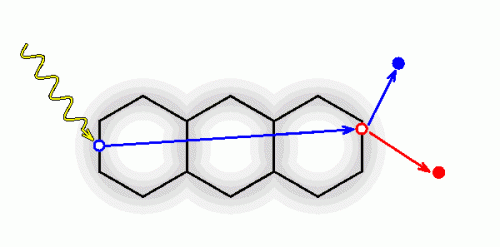Size matters - even for molecules

Two electrons that are emitted from a large molecule by a single photon may originate from far apart within that molecule. In a recent study on hydrocarbon molecules consisting of one to five fused benzene rings (each ring consisting of six carbon atoms), SRC researchers Tim Hartman and Ralf Wehlitz have found that the relative probability for ejecting two electrons scales linearly with the length of the molecule.
This indicates that the two electrons can originate at the two opposite ends of the molecule, which, in this case, is up to 1.4 nm or about 10 times the diameter of a carbon atom apart. This observation also implies that the production of stable doubly charged parent ions relative to singly charged parent ions is rather large for large molecules leading to the emission of many slow electrons.
When a slow electron attaches to another molecule, such as a large bio-molecule, it makes it prone to radiation damage, so that such "marked" molecule can easily fragment.
The publication of this paper by SRC Researchers Tim Hartman and Ralf Wehlitz can be found at T. Hartman et al., PRL 108, 023001 (2012).
Provided by University of Wisconsin-Madison




















